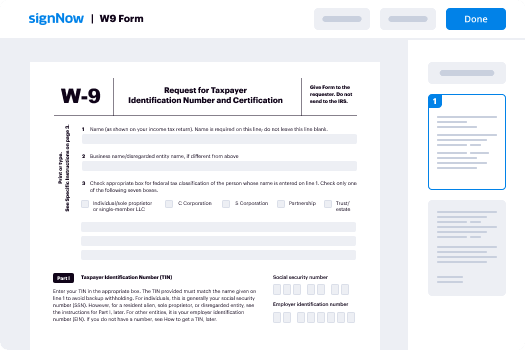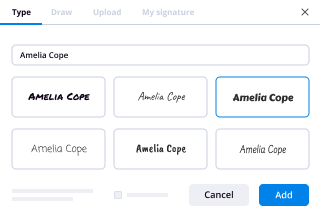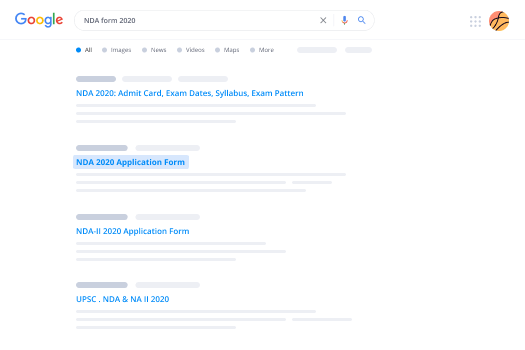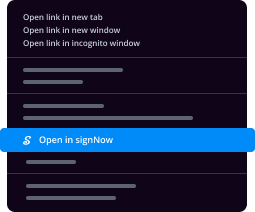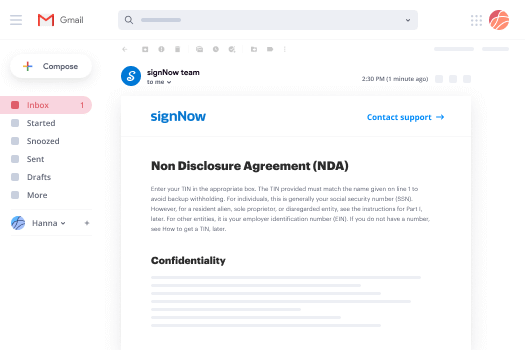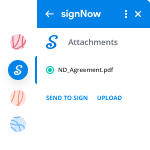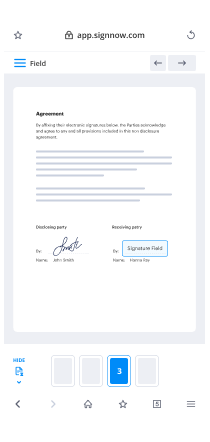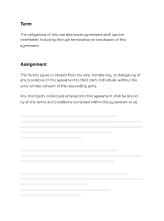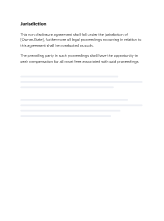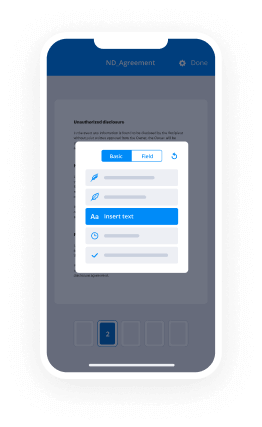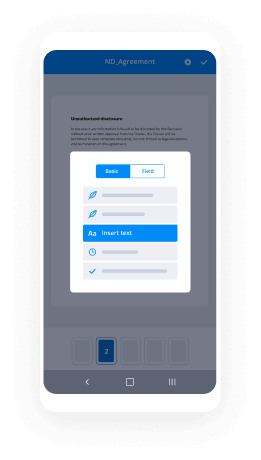Get Started with eSignature: Electronic Signature Systems
- Quick to start
- Easy-to-use
- 24/7 support
Simplified document journeys for small teams and individuals




We spread the word about digital transformation
Why choose airSlate SignNow
-
Free 7-day trial. Choose the plan you need and try it risk-free.
-
Honest pricing for full-featured plans. airSlate SignNow offers subscription plans with no overages or hidden fees at renewal.
-
Enterprise-grade security. airSlate SignNow helps you comply with global security standards.







Quick-start guide on how to use electronic signature systems feature
Is your organization ready to cut inefficiencies by about three-quarters or even more? With airSlate SignNow eSignature, weeks of contract negotiation become days, and hours of signature collection become a few minutes. You won't need to learn everything from scratch due to the user-friendly interface and easy-to-follow guides.
Complete the following steps below to use the electronic signature systems functionality in minutes:
- Launch your browser and visit signnow.com.
- Subscribe for a free trial or log in using your email or Google/Facebook credentials.
- Select User Avatar -> My Account at the top-right corner of the webpage.
- Personalize your User Profile by adding personal information and altering settings.
- Make and manage your Default Signature(s).
- Go back to the dashboard webpage.
- Hover over the Upload and Create button and select the needed option.
- Click the Prepare and Send option next to the document's name.
- Type the name and email address of all signers in the pop-up window that opens.
- Use the Start adding fields menu to proceed to edit file and self sign them.
- Click on SAVE AND INVITE when completed.
- Continue to configure your eSignature workflow employing advanced features.
It can't get any simpler to use the electronic signature systems feature. It's accessible on your mobile phones as well. Install the airSlate SignNow app for iOS or Android and manage your custom eSignature workflows even while on the go. Forget printing and scanning, time-consuming filing, and costly papers delivery.
How it works
Rate your experience
What is the electronic signature systems
Electronic signature systems provide a digital method for signing documents, allowing users to authenticate their identity and consent to the contents of a document electronically. These systems streamline the signing process by eliminating the need for physical signatures, enabling users to complete transactions quickly and securely online. With features such as document tracking and audit trails, electronic signature systems enhance the efficiency of workflows while ensuring compliance with legal standards.
How to use the electronic signature systems
Using electronic signature systems involves a few straightforward steps. First, users upload the document they wish to sign or send for signature. Next, they can add fields for signatures, dates, or other required information. After configuring the document, users can send it to the intended recipients for their signatures. Once all parties have signed, the completed document is securely stored and can be easily accessed for future reference.
Steps to complete the electronic signature systems
Completing a document using electronic signature systems typically involves the following steps:
- Upload the document to the electronic signature platform.
- Add signature fields and any additional required fields, such as dates or initials.
- Enter the email addresses of the signers and customize the message if desired.
- Send the document for signature.
- Monitor the signing process to ensure all parties have signed.
- Download or store the signed document securely once all signatures are collected.
Legal use of the electronic signature systems
In the United States, electronic signatures are legally recognized under the Electronic Signatures in Global and National Commerce (ESIGN) Act and the Uniform Electronic Transactions Act (UETA). These laws establish that electronic signatures hold the same legal standing as traditional handwritten signatures, provided that both parties consent to use electronic means for signing. It is essential to ensure that the electronic signature system used complies with these regulations to maintain the legality of signed documents.
Security & Compliance Guidelines
Security is a critical aspect of electronic signature systems. Users should ensure that the platform employs robust encryption methods to protect sensitive information during transmission and storage. Additionally, compliance with industry standards such as the General Data Protection Regulation (GDPR) and the Health Insurance Portability and Accountability Act (HIPAA) is vital for organizations handling personal or health-related data. Regular audits and user authentication measures further enhance the security of the signing process.
Documents You Can Sign
Electronic signature systems can be used for a wide range of documents, including:
- Contracts and agreements
- Non-disclosure agreements (NDAs)
- Employment forms and HR documents
- Invoices and purchase orders
- Real estate documents
- Tax forms
This versatility makes electronic signature systems an essential tool for businesses across various industries, facilitating faster transactions and improved document management.
Sending & Signing Methods (Web / Mobile / App)
Electronic signature systems offer various methods for sending and signing documents. Users can access the platform via web browsers, mobile applications, or dedicated software. This flexibility allows signers to review and sign documents from any location, whether in the office or on the go. The user-friendly interfaces ensure that the process remains straightforward, regardless of the device used.
-
Best ROI. Our customers achieve an average 7x ROI within the first six months.
-
Scales with your use cases. From SMBs to mid-market, airSlate SignNow delivers results for businesses of all sizes.
-
Intuitive UI and API. Sign and send documents from your apps in minutes.
FAQs
-
What are electronic signature systems?
Electronic signature systems are digital solutions that allow users to sign documents electronically, eliminating the need for physical signatures. These systems ensure the authenticity and integrity of the signed documents, making them legally binding in many jurisdictions. With airSlate SignNow, businesses can streamline their signing processes and enhance productivity.
-
How does airSlate SignNow compare to other electronic signature systems?
airSlate SignNow stands out among electronic signature systems due to its user-friendly interface and robust features. It offers customizable templates, advanced security measures, and seamless integrations with popular applications. This makes it an ideal choice for businesses looking for an efficient and reliable eSignature solution.
-
What are the pricing options for airSlate SignNow's electronic signature systems?
airSlate SignNow offers flexible pricing plans to accommodate businesses of all sizes. Whether you are a small startup or a large enterprise, you can choose a plan that fits your budget and needs. Each plan includes essential features of electronic signature systems, ensuring you get the best value for your investment.
-
What features do electronic signature systems like airSlate SignNow offer?
airSlate SignNow provides a comprehensive suite of features within its electronic signature systems, including document templates, real-time tracking, and automated reminders. Additionally, it supports multiple file formats and allows for in-person signing, making it versatile for various business needs. These features enhance the overall signing experience for both senders and recipients.
-
Are electronic signature systems secure?
Yes, electronic signature systems like airSlate SignNow prioritize security to protect sensitive information. They utilize encryption, secure servers, and compliance with industry standards such as GDPR and eIDAS. This ensures that your documents are safe and that the signatures are legally valid.
-
Can airSlate SignNow integrate with other software?
Absolutely! airSlate SignNow's electronic signature systems can seamlessly integrate with a variety of third-party applications, including CRM, document management, and cloud storage solutions. This integration capability enhances workflow efficiency and allows businesses to manage their documents more effectively.
-
What are the benefits of using electronic signature systems for businesses?
Using electronic signature systems like airSlate SignNow offers numerous benefits, including faster turnaround times, reduced paper usage, and improved document tracking. Businesses can save time and resources while ensuring compliance and security. This leads to enhanced customer satisfaction and streamlined operations.
airSlate SignNow capabilities for electronic signature systems
Related searches to electronic signature systems
Join over 28 million airSlate SignNow users
Get more for electronic signature systems
- Achieve Online Signature Lawfulness for Company Bonus ...
- Maximize the Legality of Online Signatures for Company ...
- Ensuring Online Signature Lawfulness for Company Bonus ...
- Unlock the Potential of Online Signature Lawfulness for ...
- Online Signature Lawfulness for Company Bonus Letter in ...
- Unlock the Online Signature Lawfulness for Company ...
- Unlock the Power of Online Signature Lawfulness for ...
- Online Signature Lawfulness for Notice of Promotion in ...





























